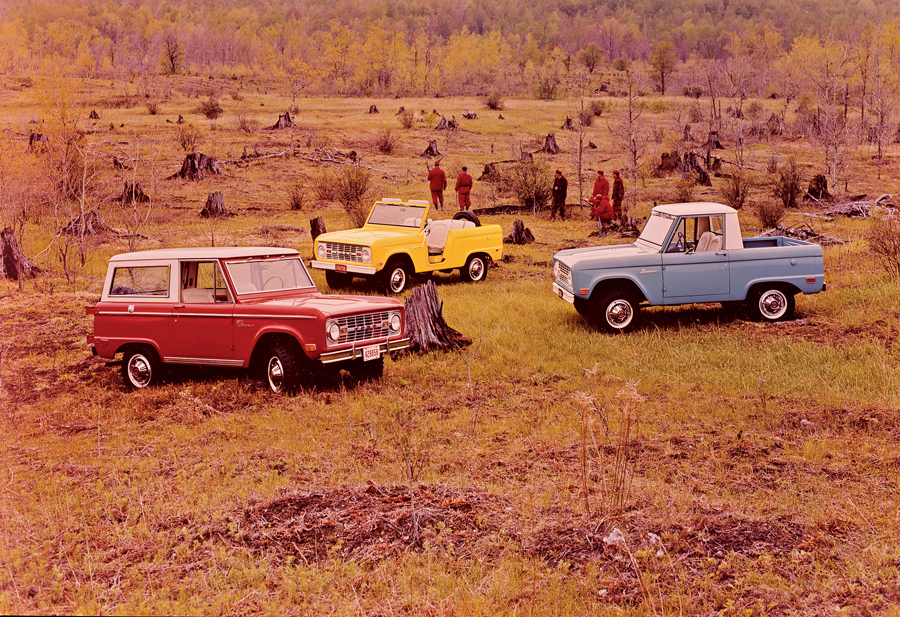
Shakespeare may have melted the hearts of star-crossed lovers when he wrote, “What’s in a name? That which we call a rose/By any other name would smell as sweet,” but he was clearly no marketing man.
Take the name “Bronco,” for example. Unless you’ve been hiding under a rock for the past couple of years, you’ve likely been inundated with news blurbs and Internet rumors of the impending return of Ford’s iconic nameplate.
There have been so many “leaked” renderings and spy photos circulating online that I’m beginning to wonder if anyone at Ford even bothers to lock the doors at night. Do you think people would be as excited about this new four-by if it were being called an Explorer? I doubt it.
The notion of legacy and its impact on consumers can be bewildering sometimes, but it can’t be denied.
Anything you can do…
All this excitement about the new Bronco got me thinking about the old Bronco, which I guess is the point. We’ve watched sale prices of the first-gen Broncos skyrocket over the past 15 years, but I can’t help but wonder what will happen to the oldies once the new ones hit the lot.
A while back I hypothesized that Jeep CJ-7 values were languishing in the doldrums when compared to the dramatic rise of similar-vintage four-bys such as the Bronco, Blazer and Scout because a modern version was readily available. And more importantly, the modern version encapsulated the essence of the original in a safer, more comfortable and more reliable package. If you want to drive a Jeep, what can an old one do that a new one can’t do better?
Similarly, if the new Bronco can deliver an old-Bronco experience without all the old-Bronco quirkiness, is it safe to assume old-Bronco prices will finally stabilize or even start to head south?
To answer that question, I looked at the trend lines for the four other classic SUVs at the forefront of the market to get a grasp on where the first-gen Bronco market is headed.
I looked at the first-gen Chevy K5 Blazer (1969–72), the Jeep Wagoneer (1963–91), the International Scout (1961–80), and the Toyota Land Cruiser FJ-40 (1960–84). And yes, I realize the FJ is not an American-made automobile, but it is an essential comparison nonetheless.
The first thing we need to recognize here is that the vintage-SUV market is on fire, with no model surging as strongly as the Bronco.
In the early- to mid-2000s, first-gen Broncos were trading consistently between $5k and $10k. The prices never faltered during the volatile years between 2005 and 2010. Instead, sale prices doubled while almost everything else in the market corrected. By 2015, sale prices had crept up another 30%–40% to about $30k, but that’s when things really got crazy. Prices for first-gen Broncos have tripled in the past five years.
In comparison, Chevrolet’s first-gen K5 Blazer comes closest to matching the Bronco’s meteoric rise, but it neither started as low nor has climbed so high. The first decade of the century saw K5s consistently trading in the $10k to $15k range, with average values climbing into the low-$20k range by 2015. As with the Bronco, the past five years have been bonkers for K5s, with prices again tripling, now into the $60k-plus range.
The International Scout and Jeep Wagoneer are worth mentioning here as well because they too have surged in value over the past 10 to 15 years, albeit a bit more erratically than our front-runners. Following along the same curve as the Bronco and K5, Scouts and Wagoneers are both trading at three to four times what they earned 10 to 15 years ago, but at a much lower price point and without the all-in confidence the Bronco and K5 have inspired.
What’s old is new again
What’s interesting here is that the valuation surges for all four of these vintage SUVs are nearly identical in slope — particularly in the case of the Bronco and K5. They’ve risen together with key market upturns that are fully in sync with one another. What’s also interesting is that none of these models have modern-day equivalents. Which brings me to the CJ and FJ.
When we compare the sale-price trends for Jeep CJ-7s and Toyota Land Cruiser FJ-40s over the past 20 years to those of the four other models, a stark contrast jumps right off the page. The CJ-7s, as I mentioned before, missed the invitation to the vintage-SUV upswing, and have been trading consistently between $5k and $15k since the turn of the century. More interesting than that, they were not spared the market correction of 2008 the way the other off-roaders were.
Surprisingly, the FJ-40’s trendline matches that of the CJ very closely, albeit about $15k higher up on the graph. What I think is most interesting about the FJ, and the reason that I thought its inclusion here was necessary, is just how similar it is to a first-gen Bronco in dimension, capability and experience. They’re also both iconic nameplates that forever shaped the face of an industry. Why, then, are their value trajectories so divergent? Do new FJs and Land Cruisers have something to do with it? My guess is yes.
So, does a rose by any other name really smell as sweet? I think first-gen Bronco owners and prospective buyers would be wise to think long and hard about that question. My guess is that no matter in what production quality the new Bronco is presented, we’ll see a quick uptick in first-gen Bronco prices. However, if the new Bronco is any good, and lessons learned through the success of the Raptor means it likely will be, my guess is that the booming old-Bronco market should prepare to finally be put out to pasture.